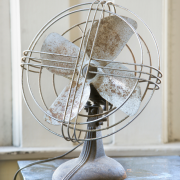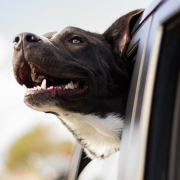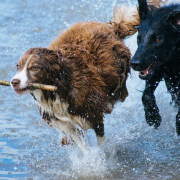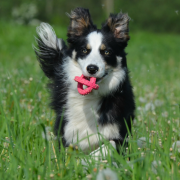Summertime Safety Tips for Man’s Best Friend
Summer is here at last, which means all kinds of fun in the sun, from barbecues to beach excursions and more. What better way to while away the summer days than with man’s best friend by your side? Before you and your pooch head out into the great outdoors be sure to put some thought into your pet’s safety. It is important to remember that dogs overheat quickly and that they need supervision around water. There are also a few things to be mindful of when it comes to barbecues and gardening.
Be Mindful of the Heat
It is widely known that dogs overheat much quicker than humans do. Your dog can get uncomfortably hot long before the dog days of summer are here. What isn’t widely known is that keeping your dog’s coat long is better than shaving off all of that fur. It seems pretty counter-intuitive, but a well maintained fur coat helps regulate your dog’s temperature and improves circulation.
 Other tricks to keep your dog cool are fairly obvious. Keep your dog hydrated, use air conditioners or fans and even frozen treats to beat the heat. Limit outdoor activity during the hottest period of the day, which is typically between 1PM and 4PM. When walking try to keep your dog on the grass instead of the asphalt, and stick to the shady side of the street. If your dog will need to be on asphalt for an extended period of time, put down a towel for him to stand on.
Other tricks to keep your dog cool are fairly obvious. Keep your dog hydrated, use air conditioners or fans and even frozen treats to beat the heat. Limit outdoor activity during the hottest period of the day, which is typically between 1PM and 4PM. When walking try to keep your dog on the grass instead of the asphalt, and stick to the shady side of the street. If your dog will need to be on asphalt for an extended period of time, put down a towel for him to stand on.
It is important to recognize the signs of heat exhaustion in your dog so that you can act quickly if it happens. Symptoms include heavy panting, dry looking or red gums, thick ropy drool, vomiting and diarrhea. If your dog is displaying these symptoms move him to a cool location. Drape damp towels over him and swap them out frequently. Take your dog’s temperature, normal is between 100 and 103 degrees, if his temperature gets up to 106 degrees he could be at risk for heat stroke. Provide your dog with cool water but don’t force him to drink and continue to check his temperature every five minutes. Even if your dog seems to be getting better it’s a good idea to check in with the vet.
The Car is No Place for a Dog
 While your dog may like to take road trips with you, it should go without saying that you should never leave your dog in the car. On a mild day, where the temperature is 70 degrees, the internal temperature of the car can reach almost 100 degrees in a span of 20 minutes. If it’s 85 degrees outside it will reach a sweltering 104 degrees in as little as ten minutes. Even if you leave the windows open and park in the shade, the car will still be too hot for your dog.
While your dog may like to take road trips with you, it should go without saying that you should never leave your dog in the car. On a mild day, where the temperature is 70 degrees, the internal temperature of the car can reach almost 100 degrees in a span of 20 minutes. If it’s 85 degrees outside it will reach a sweltering 104 degrees in as little as ten minutes. Even if you leave the windows open and park in the shade, the car will still be too hot for your dog.
A Cool Dip
 Swimming is a great reprieve from the harsh summer sun. Definitely invest in a good life vest for your dog, get one that is brightly colored so that you and others can easily spot him in the water. At the beach or at rivers be on the lookout for riptides because your pet could quickly be swept out to sea. In a lake or a pond, skip the swim if it is covered in blue-green algae, it could be toxic to your dog. If you have a pool you need to train him how to exit the pool by himself, make sure that you practice it over and over and over so that he’ll remember how to get out if he gets tired or falls in. You might also want to consider getting a dog friendly ramp installed in the deep end of the pool for good measure.
Swimming is a great reprieve from the harsh summer sun. Definitely invest in a good life vest for your dog, get one that is brightly colored so that you and others can easily spot him in the water. At the beach or at rivers be on the lookout for riptides because your pet could quickly be swept out to sea. In a lake or a pond, skip the swim if it is covered in blue-green algae, it could be toxic to your dog. If you have a pool you need to train him how to exit the pool by himself, make sure that you practice it over and over and over so that he’ll remember how to get out if he gets tired or falls in. You might also want to consider getting a dog friendly ramp installed in the deep end of the pool for good measure.
Avoid Human Foods
Barbecues are another seemingly innocuous activity that can be dangerous for dogs. They can be great opportunities to socialize your dog with friends and neighbors so it would be a shame to keep them indoors. Make sure that all of your guests know not to feed him scraps of fatty meats, bones or corn on the cob. In fact it might be best that they don’t feed him any people food at all. Keep an eye on your dog around charcoal briquettes, they are surprisingly tasty to him and can wreak all sorts of digestive system havoc.
Keep Your Garden Safe for Fido
Dogs make great gardening buddies once you teach them not to ‘help’ you dig holes. You might want to opt for dog friendly plants and flowers since dogs are more likely to stop and eat the flowers than smell them. Try to avoid sago palms, dieffenbachia, azaleas, kalanchoes and lilies as they are toxic to pets. Many fertilizers are harmless, just try to steer clear of types that have blood, bone or feather meal in them, they are tempting to eat and they can cause bowel obstructions. In terms of insecticides and pesticides if you have to use them, make sure that you select ones without organophosphates.
Overall, summer is one of the best times be a dog owner and also one of the most dangerous. Don’t let that deter you though, with a little foresight and some precautions it is easy enough to avoid disaster. Summer activities are infinitely more rewarding when you can share them with your furry friends so get out there and start making memories that will last a lifetime!



